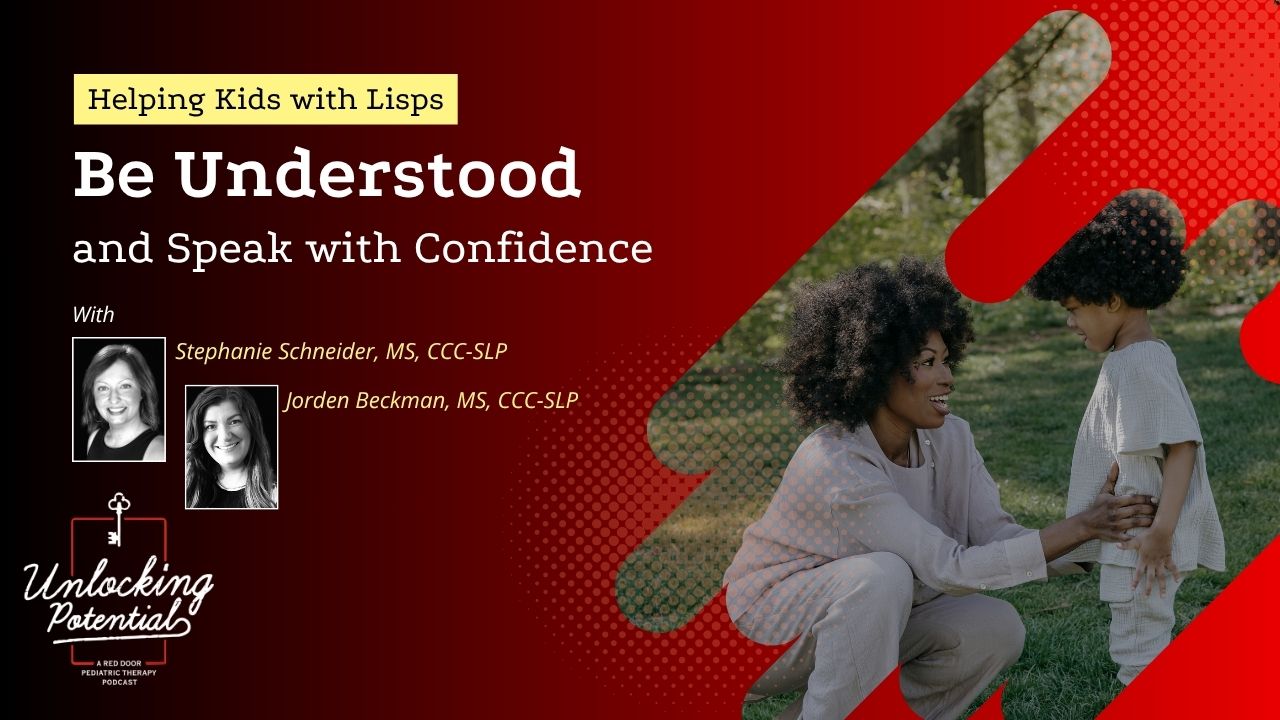It’s easy to overlook a lisp as something a child might “grow out of.” But when certain sounds are hard to produce, it can affect how well a child is understood—not just at home, but out in the world. For some kids, it becomes a source of frustration, especially when others frequently ask them to repeat themselves. Speech therapy can help.
Understanding how lisps develop, when to seek support, and what therapy looks like can help caregivers make confident, informed decisions for their child.
Understanding What a Lisp Really Is
A lisp is a type of articulation difference that affects how certain sounds are made, especially S and Z. There are two common types:
- Frontal lisps happen when the tongue pushes against or between the front teeth. This often makes an S sound more like a TH—“sun” becomes “thun.”
- Lateral lisps occur when air escapes over the sides of the tongue instead of flowing down the middle. This creates a slushy or wet-sounding distortion.
Lisps can also affect other sounds that rely on tongue placement and airflow, like SH, CH, and the J sound. It’s not just about one tricky sound—it’s about how the tongue and air are working together.
Why Lisps Can Affect Communication
S and Z sounds show up constantly in English. In fact, S is the fourth most common sound in everyday conversation. When those sounds are distorted, speech can lose some of its clarity—especially in busy environments or when a child is speaking quickly or from another room.
Sometimes a lisp can even change the meaning of what a child is trying to say. For example, a frontal lisp might turn “sink” into “think,” which can confuse listeners. Family members may get used to the pattern and understand without much effort, but people outside the home often struggle more.
When to Be Concerned
A lateral lisp should be addressed early—around age 3—because it’s never considered a typical part of speech development. Frontal lisps are a bit different. While they can be developmental for young children, by age 4 we expect the tongue to begin moving back behind the teeth where it belongs.
These ages often surprise parents. But the earlier a lisp is addressed, the easier it is to guide the tongue into a new habit and support clear speech.
What Speech Support Looks Like
When a child comes in for speech support, the first step is understanding what’s contributing to the lisp. That means looking at more than just how a child talks.
A full assessment may include:
- The structure of the mouth, including jaw alignment and the frenulum (the tissue under the tongue)
- Resting posture, like where the tongue sits and whether the child breathes through their mouth or nose
- A standard articulation assessment to see if other sounds are affected
One reason lisps can take time to address is that they’re rooted in habit. As Jorden Beckman, MS, CCC-SLP, explains, “The tongue is a muscle, so you really have to work on that movement and placement at home as well as in therapy.”
What to Expect from the Process
In most cases, therapy starts with a plan to work together for about six months, with regular check-ins to track progress. Some children move quickly once they understand where their tongue should be. For others—especially if they’ve had a lisp for years—it takes time to build a new habit.
The most important factor in progress is practice. Therapy once a week isn’t enough without follow-through at home. Caregivers play a key role in helping children retrain their muscles and reinforce what’s being learned.
School-Based vs. Private Speech Therapy
Families often wonder whether school-based services are enough—or if private therapy is still necessary. The answer depends on the situation.
In schools, speech support is generally provided only when a speech difference impacts academic performance. Since lisps don’t always affect learning, children with lisps may not qualify for school-based services. Private therapy offers more flexibility, earlier intervention, and one-on-one time that can make a real difference in establishing new speech patterns.
It’s also possible to use both school and private therapy at the same time, giving kids even more support.
Common Causes and Habits to Watch
In many cases, there’s no clear reason a child develops a lisp. But certain habits are known to contribute—especially when they continue beyond early infancy.
These include:
- Prolonged use of pacifiers or bottles beyond 12 months
- Extended thumb sucking or sucking on blankets and clothing
- Frequent use of hard-spout sippy cups
All of these keep the tongue low and forward in the mouth, which reinforces the kind of placement that causes a lisp. If a child is still using a pacifier past their first birthday, it may be time to consider weaning. Therapy can help with that process too—especially when the whole family is ready to make the change together.
Encouragement for Families
Lisps are among the most common speech sound concerns in young children, especially between the ages of 2 and 5. Some resolve on their own. Many don’t.
If you’ve noticed that your child’s speech sounds different—or if others frequently ask them to repeat themselves—it might be time for a screening. In some cases, no therapy is needed at all. But when it is, getting the right support early makes it easier for kids to feel confident in their speech and better understood by the people around them.

